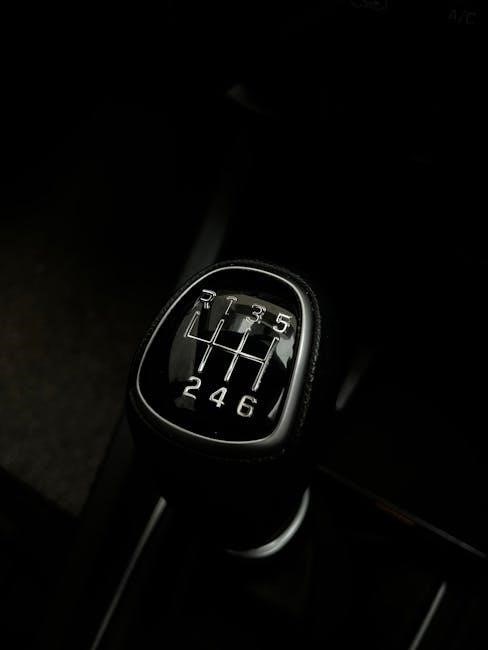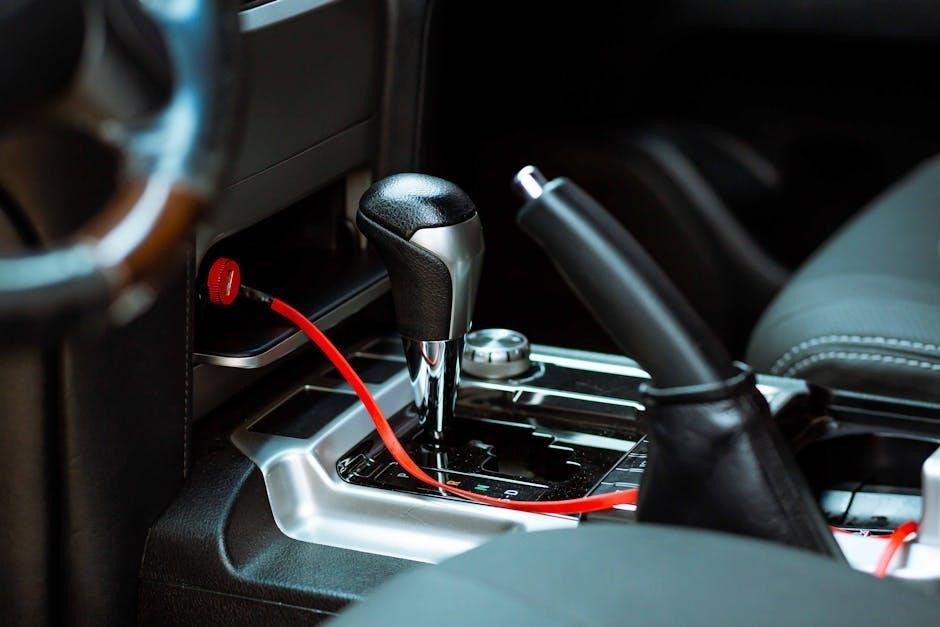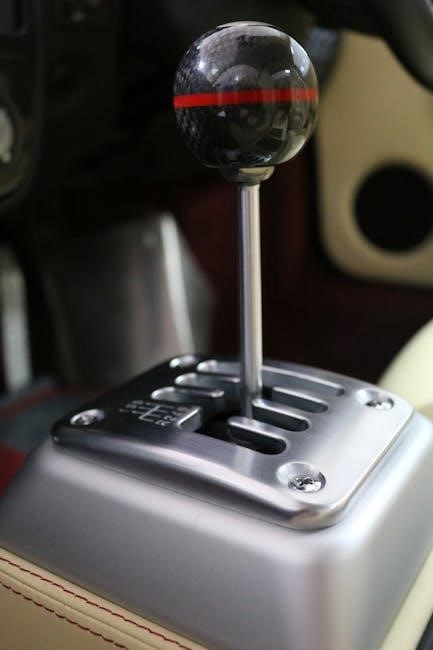
The Lexus IS 250 is a popular compact executive car known for its blend of luxury, performance, and reliability․ It offers a refined driving experience and stylish design that appeals to a wide range of car enthusiasts․
The Lexus IS 250 was offered with a manual transmission in certain model years, providing drivers with a more engaging driving experience․ This option catered to those who prefer greater control over gear changes and engine speed․
The Lexus IS 250 is a compact executive car known for its blend of luxury and performance, often considered a reliable option in the used car market․ Several consumer reviews and ratings highlight its appeal, especially for those looking at older models․ Available from 2006 to 2013, the IS 250 provides a comfortable ride and stylish design․ While many models feature automatic transmissions, the availability of a manual transmission in specific years caters to driving enthusiasts․ The IS 250’s engine and transmission have generally received positive feedback regarding reliability, making it a popular choice for those seeking a balance of sportiness and dependability in a used vehicle․ The manual transmission enhances the driving experience․
The Lexus IS 250 was offered with a manual transmission in certain model years, providing drivers with a more engaging driving experience․ This option catered to those who prefer greater control over gear changes and engine speed․

Overview of the IS 250 Manual Transmission
The Lexus IS 250 is a compact executive car known for its blend of luxury and performance, often considered a reliable option in the used car market․ Several consumer reviews and ratings highlight its appeal, especially for those looking at older models․ Available from 2006 to 2013, the IS 250 provides a comfortable ride and stylish design․ While many models feature automatic transmissions, the availability of a manual transmission in specific years caters to driving enthusiasts․ The IS 250’s engine and transmission have generally received positive feedback regarding reliability, making it a popular choice for those seeking a balance of sportiness and dependability in a used vehicle․ The manual transmission enhances the driving experience․
Availability of Manual Transmission in IS 250 Models
The IS 250 was available with a manual transmission, specifically in the sport sedan configuration․ This option provided drivers with more control and a more engaging experience․ Finding an IS 250 with a manual transmission can be more challenging․ The manual transmission was paired with a rear-wheel-drive setup, enhancing its sporty character․ The 2007 Lexus IS 250, for example, was offered as a 4-door sport sedan with a manual transmission and rear-wheel drive․ For those seeking a more connected driving experience, the manual transmission option remains a desirable feature in the IS 250․
Technical Specifications of the IS 250 Manual Transmission
The IS 250 manual transmission features specific gear ratios designed to optimize performance and fuel efficiency․ These ratios play a crucial role in acceleration, top speed, and overall driving dynamics of the vehicle․
Gear Ratios and Performance
The gear ratios in the IS 250’s manual transmission are carefully selected to balance acceleration and fuel economy․ Specific ratios dictate how much engine torque is multiplied at each gear, influencing the car’s responsiveness․ A shorter (numerically higher) final drive ratio can enhance acceleration but may reduce fuel efficiency at higher speeds․ Conversely, a taller (numerically lower) ratio can improve fuel economy but might make the car feel less responsive․
The F-Sport quick shifter and fine-tuned clutch cables are aftermarket parts that improve the IS 250’s manual transmission, resulting in quicker shifts and rpms that fall faster․ These modifications enhance the driving experience, making it feel more spirited․
C250 Manual Transmission Details
The C250 manual transmission, often referenced in technical documents, provides detailed specifications, construction information, and operating principles․ This information is invaluable for mechanics and enthusiasts seeking to understand the inner workings of the transmission․ This data includes detailed schematics, material compositions, and tolerances which are crucial for maintenance and repairs․
Understanding the C250’s specific design helps ensure proper operation and longevity․ The technical manual offers insights into the transmission’s components, lubrication requirements, and potential failure points․ This knowledge enables informed decisions regarding maintenance and troubleshooting․
Reliability of the IS 250 Manual Transmission
The Lexus IS 250 manual transmission has faced some reliability concerns, primarily involving the gearbox․ Owners have reported issues impacting the overall driving experience of the vehicle․
Common Issues and Concerns
The manual transmission in the Lexus IS 250 has been reported to have several reliability concerns․ Some owners have experienced difficulty shifting gears, particularly when the transmission is cold․ Noises such as whining or grinding sounds during gear changes have also been reported․ Premature clutch wear is another common issue, potentially requiring more frequent replacements compared to automatic transmissions․
These problems can significantly affect the driving experience, making it less smooth and enjoyable․ Potential buyers should be aware of these potential issues and thoroughly inspect the transmission before purchasing a used IS 250 with a manual gearbox․ Addressing these concerns early can help prevent more serious and costly repairs down the line․
Comparison with Automatic Transmission Reliability
Compared to the automatic transmission, the manual transmission in the IS 250 tends to have a different set of reliability concerns․ While automatic transmissions may face issues like valve body problems or torque converter failures, the manual transmission typically encounters clutch wear, shifting difficulties, and potential gearbox noises․
Generally, automatic transmissions in the IS 250 are considered more reliable overall, requiring less frequent maintenance and repairs than their manual counterparts․ However, the longevity of both transmission types heavily depends on driving habits and maintenance schedules․ Regular fluid changes and careful driving can extend the lifespan of either transmission, but the manual version might need more attentive care to avoid common issues․
Driving Experience and Performance Enhancements
Enhancing the driving experience of a manual IS 250 can be achieved through aftermarket parts like short shifters and performance clutches, leading to quicker shifts and improved power delivery․
Improvements with Aftermarket Parts
For enthusiasts seeking to elevate the driving experience of their IS 250 manual transmission, aftermarket parts offer a range of enhancements․ Installing a short shifter kit can significantly reduce shift times, providing quicker and more precise gear changes․ Upgrading to a performance clutch kit improves the clutch’s ability to handle increased power and torque, particularly beneficial for modified engines․
Furthermore, modifications like a clutch accumulator delete can refine clutch feel, offering a more direct connection between the driver and the transmission․ Fine-tuning clutch cables ensures optimal shifting behavior․ A lighter flywheel can also improve throttle response and acceleration․ These modifications collectively contribute to a more engaging and responsive driving experience, transforming the IS 250 into a spirited and enjoyable machine․
Impact of Manual Transmission on Carbon Build-up
Carbon build-up is a known issue in some engines, and the type of transmission can have an indirect impact․ While not a direct cause, a manual transmission might offer some advantages in mitigating carbon accumulation compared to an automatic․ The greater control over engine RPM afforded by a manual gearbox allows drivers to more frequently engage in spirited driving, potentially aiding in burning off carbon deposits․
Specifically, higher RPM operation can help to clean the intake valves and combustion chamber․ This is relevant, as carbon build-up often manifests as stalling or rough idling, particularly when decelerating․ Unlike an automatic, a manual transmission gives the driver the option to downshift and maintain higher engine speeds, potentially reducing the severity of carbon-related issues over time․

Manual Transmission in Other Vehicles with 250 Engines
The GM 250 inline-six engine, often paired with a three-speed manual transmission, was a base-model option in various mid- and full-size cars from 1966 to 1979, providing reliable performance․
GM 250 Inline-Six Engine Applications
The GM 250 inline-six engine, a staple in American automotive history, found its home in numerous vehicles from 1966 to 1979․ This engine was commonly paired with a manual transmission, often a three-speed, offering drivers a straightforward and engaging experience․ GM phased out the 250 in favor of smaller V6, V8, and I4 engines such as the Chevy 305 and the GM Iron Duke inline-four․
These combinations were prevalent in mid-size and full-size cars, as well as light-duty trucks, providing a balance of power and fuel efficiency for the era․ The simplicity of the inline-six design, combined with the manual transmission, made these vehicles relatively easy to maintain and repair․ The 250 straight-six was most often mated to a three-speed manual transmission or a three-speed Turbo-Hydramatic automatic․
Ford F-250 Manual Transmission Considerations
When considering a manual transmission in a Ford F-250, several factors come into play․ The F-250, known for its ruggedness and towing capabilities, often features manual transmissions in older models, particularly those equipped with the 7․3L Powerstroke diesel engine․ These manual transmissions, typically 5 or 6-speed, offer enhanced control and a more direct connection to the vehicle, appealing to drivers who prioritize a hands-on experience․
However, potential buyers should be aware of the transmission’s condition, especially in high-mileage trucks․ Common issues include clutch wear and synchro problems․ The 6 speed manual transmission is also known to be very robust․ A well-maintained manual F-250 provides a reliable and capable workhorse, but thorough inspection is crucial․
The rear end gear ratio significantly affects the driveability and towing capacity of a vehicle with a manual transmission․ Lower gear ratios improve acceleration and towing, while higher ratios enhance fuel efficiency and top speed․
Impact on Driveability and Towing
Selecting the appropriate rear end gear ratio is crucial for optimizing the driving experience and towing capabilities of a Lexus IS 250 equipped with a manual transmission․ A lower gear ratio, such as 3․73 or 4․10, provides enhanced acceleration and increased torque, making it ideal for towing or driving in hilly terrain․ This configuration allows the engine to reach its peak power band more quickly, resulting in quicker off-the-line performance and improved responsiveness․
However, lower gear ratios can also lead to higher engine RPMs at highway speeds, potentially reducing fuel economy․ Conversely, a higher gear ratio, such as 3․08 or 3․42, prioritizes fuel efficiency and reduces engine strain during long-distance cruising․ This setup is better suited for drivers who primarily use their IS 250 for daily commuting or highway driving and do not require significant towing capacity․ The trade-off is a decrease in acceleration and towing performance, as the engine will need to work harder to overcome inertia and maintain speed, especially when carrying heavy loads․

Rear End Gear Ratio Considerations with Manual Transmission
Choosing the Right Gear Ratio (e․g․, 3․42 vs 3․73)
Selecting the ideal rear end gear ratio for an IS 250 manual transmission involves balancing performance, fuel economy, and driving style․ A 3․42 gear ratio offers a compromise between acceleration and fuel efficiency, suitable for drivers seeking a balance between daily drivability and occasional spirited driving․ It provides a noticeable improvement in acceleration compared to higher ratios while maintaining reasonable fuel consumption on the highway․
Conversely, a 3․73 gear ratio emphasizes acceleration and towing capacity, making it a better choice for drivers who prioritize quicker off-the-line performance and frequently carry heavier loads․ This ratio will deliver a more engaging driving experience․ However, it will result in higher engine RPMs at cruising speeds, leading to reduced fuel economy and potentially increased engine wear․ Ultimately, the decision depends on the driver’s specific needs and preferences․

Posi Traction and its Effects
Posi traction, or limited-slip differential, enhances traction by distributing power to both rear wheels․ In snow, this can provide improved grip and control, but may also induce oversteer if not handled carefully․
Posi Traction in Snow Conditions
Posi traction, or a limited-slip differential, can significantly impact a vehicle’s behavior in snowy conditions․ Unlike an open differential where power is sent to the wheel with the least traction, posi traction distributes power more evenly between both rear wheels․ This can provide enhanced grip when one wheel starts to slip, allowing the vehicle to maintain momentum and control․ However, it’s crucial to understand that posi traction can also make the rear end more prone to sliding, especially on icy surfaces․
Experienced drivers can use this characteristic to their advantage, initiating controlled drifts for better maneuverability․ Novice drivers, however, might find the sudden loss of traction challenging, potentially leading to oversteer or loss of control․ Therefore, when driving an IS 250 with posi traction in snow, it is essential to exercise caution, reduce speed, and be prepared for potential rear-end movement․ Winter tires are highly recommended to maximize grip and safety․
Braking System Considerations with Posi Traction
When a vehicle is equipped with posi traction, it’s important to consider how it interacts with the braking system, especially in emergency situations or adverse conditions․ Posi traction can affect the car’s stability during braking, potentially leading to different handling characteristics compared to a vehicle with an open differential․ In situations where one wheel encounters a low-traction surface, the posi traction can maintain torque to both wheels, which might affect ABS engagement․
It’s crucial to ensure that the braking system is in good working order, with properly functioning ABS and evenly worn brake pads․ Upgrading to performance brake pads and rotors can enhance stopping power and improve overall braking performance․ Furthermore, drivers should familiarize themselves with the vehicle’s braking behavior in various conditions to maintain control and avoid unexpected skidding or loss of stability․ Adjusting driving habits to match the conditions is paramount for safe operation․